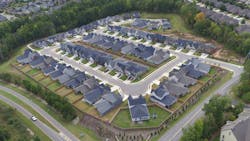In Alabama, a proof of concept for GEBs exceeds expectations
Replacing our country’s aging power transmission and distribution infrastructure will require significant investment. Even with the steady push for renewable energy sources, such as wind and solar, many points in the grid are already at capacity.
Buildings now account for more than 70% of the nation’s electricity consumption and at least one-third of its emissions, according to the U.S. Department of Energy (DOE). Increasing building efficiency is not enough to save the power grid. Distributed energy resources (DERs) and grid-interactive efficient buildings (GEBs) also must be integrated into the grid.
According to DOE, GEBs—rhymes with Debs—are energy-efficient smart buildings characterized by the use of DERs to optimize energy use for grid services, occupant needs and preferences, and cost reductions in a continuous and integrated way.
What does that mean? Brett Bridgeland, manager at RMI’s Carbon-Free Buildings practice, simplifies it: “The old grid model is analogous to cable television. You’re the recipient of services, and somebody else decides what is put out there. You receive it, and you pay for it. Maybe there’s some adjustment to what the public wants, but that can be a slow process.”
Meanwhile, the new platform of interconnectivity will be ultimately more like the internet. “With the connected grid,” Bridgeland continues, “you can be a consumer if you want, but you can also contribute to it, interact with it, and even make money off it. You will also see other providers coming into the space to create platforms to support you.”
DOE has high hopes for GEBs. As documented in its National Roadmap for Grid-Interactive Efficient Buildings, if GEBs become mainstream, our power system could see cost savings in the hundreds of billions. Nationwide, our carbon emissions—and the stress on our national grid—would drop.
[I]f GEBs become mainstream, our power system could see cost savings in the hundreds of billions.
GEBs use energy in efficient ways and at efficient times. They communicate with the power grid and other connected buildings, and they use analytics and intelligent controls to optimize electricity use, flexibility, and occupant preferences. They also are reliable, which is important given the increasing frequency of extreme weather events—nobody wants another Texas power crisis of 2021, which left millions without power during record low temperatures.
In a 2021 analysis for the New York State Energy Research and Development Authority (NYSERDA), Basalt, Colo.–based consultancy RMI examined buildings capable of flexing their energy demands by, for example, running appliances during nonpeak hours and preheating or precooling to use their thermal mass to float through peak load times. But the resulting carbon savings were modest, they discovered, because today’s grid-generation mix is relatively static with minimal renewables and significant reliance on fossil fuels.
When RMI and NYSERDA placed the building-energy profile models into “proxy grid scenarios” with high penetrations of renewables and intermittency, the carbon-reduction potential was greater. By shifting loads and accounting for variables, such as regional weather conditions, they saw a 10% carbon savings. The savings increased further as the simulated grid became more decarbonized.
“The technologies and approaches to do that are available today,” Bridgeland says. “The question is how to automate that so you don’t need a person turning a dial?”
In the South, researchers from Oak Ridge National Laboratory (ORNL) are trying to answer that very question.
Ingredients of a successful connected community
In Hoover, Ala., Reynolds Landing is what electric utility Alabama Power calls a Smart Neighborhood. Completed in 2018, the 62-unit residential development was born as a public–private research project with collaborators Southern Co., Alabama Power’s parent company; Signature Homes, the builder; ORNL; DOE Building Technologies Office; DOE Office of Electricity; Electric Power Research Institute; and several technology vendors, including Carrier, Rheem, and Vivint. Within six months of unveiling a model home in the development, the team sold all 62 houses, which ranged from the low $300,000s to $400,000, according to a May 2018 AL.com article.
The neighborhood features a 1-megawatt microgrid with a solar array, battery storage, and a natural gas–fired backup generator. Each residence is equipped with smart thermostats, connected heat pump water heaters, and air-source heat pumps for air conditioning. The residences receive power from both the microgrid and the power grid.
Reynolds Landing aimed to validate at scale emerging technologies, including energy-efficient buildings, a cloud-based integrated software framework for monitoring and controlling energy use, centralized community-scale microgrid resources, and transactive controls.
Homeowners had to agree to share anonymized, end-use data with Alabama Power and its research partners for two years. Last collected in 2021, the data allowed researchers to pinpoint which building systems were big and small consumers of energy. HVAC systems and water heaters were of particular interest; ORNL R&D software engineer Helia Zandi says these systems typically make up more than 47% of a residence’s energy consumption.
Reynolds Landing residences have Home Energy Rating System (HERS) scores of 45, which is 36% more efficient than houses built to the current Alabama code (2015 International Energy Conservation Code), which have an average HERS of 70. Data from 2019 showed the Reynolds Landing homes performed better than researchers expected, consuming 44% less electricity. Furthermore, the neighborhood’s peak heating electric demand was 34% less than that of a similar all-electric community.
The optimization of controls at Reynolds Landing was suspended temporarily in 2020 because of the COVID-19–related “Safer at Home” order in Alabama. But even with individuals staying longer at home, the project’s daily energy use was still 21% lower than the baseline neighborhood.
The Reynolds Landing development “was a very large system integration effort,” Zandi says. Each home has multiple sensors on equipment, multiple HVAC system zones, two thermostats, and hundreds of different circuit-level metering data. Multiply that by 62.
On top of collecting and the integrating vendor APIs, Zandi says, the researchers had to integrate ORNL’s software with Alabama Power’s software and fuel pricing, weather, and solar forecasts.
One result of this enormous effort is the development of a cloud-based, novel control strategy to achieve grid-responsive control of a home’s energy loads and various grid services while improving homeowner comfort and reducing energy bills. CSEISMIC (Complete System Level Efficient and Interoperable Solution for Microgrid Integrated Controls), an open-source microgrid controller by ORNL, operates and controls the microgrid energy generation and storage to balance load control for cost-effectiveness and efficiency, without requiring any action of the homeowner.
Overcoming barriers to GEBs adoption
GEBs’ full adoption by the building industry and consumers faces obstacles, several of which DOE identifies in its roadmap. Potential solutions focus on deployment, development, education, utility integration, and government support.
Current market rules limit aggregator incentives to deploy grid-interactive technology. DOE defines an aggregator as “any marketer, broker, public agency, city, county, or special district that combines the loads of multiple end-use customers in negotiating the purchase of electricity, the transmission of electricity, and other related services.” The building sector also lacks awareness and training in smart technology, and the value of enabling flexible energy efficiency and demand is often overlooked in utility planning.
Building owners and homeowners might view grid-interactive technology as expensive and complex. They might worry about data privacy with the interconnectivity. Efforts to clarify GEBs’ value proposition might nudge up consumer adoption.
DOE recommends enhancing the value for consumers and the utility companies through incentives; education about dynamic price-based programs; and the coupling of new technology with the familiar. Everyone loves their smart thermostat, so why not bundle it with a smart HVAC system and heat pump water heater?
To support the planning, design, and operations of GEBs, building professionals and researchers can enhance efficiency assessment tools and building management systems, and develop assessment protocols that can integrate with the commissioning process and include demand flexibility and GHG emission information. Training students and professionals at all experience levels on advanced controls, automation, and systems integration is also imperative.
The way to increase adoption of GEBs is simple: Show end users the value.
Next steps for GEBs
Building owners, contractors, and architects can become a part of the GEBs conversation and even GEBs champions today. Ask your BMS vendor for tracking and controls on energy efficiency, energy storage, renewable energy, and load flexibility technologies on their platforms.
Let your energy aggregators know you are interested in optimizing your building’s energy efficiency through load flexible technologies. While an aggregator’s value lies in their ability to provide their customers with competitive electricity and natural gas prices and expand renewable energy options, the ability to do so comes from grouping multiple customers into one entity.
The way to increase adoption of GEBs is simple: Show end users the value.
Talk to your legislators about expanding funding and financing options for GEB technologies and adopting energy efficiency codes and standards for appliances and buildings to incorporate demand flexibility.
Join organizations like the New Buildings Institute (NBI), which, in partnership with the U.S. Green Building Council, is leading a national coalition “committed to better integrating buildings into utility grid management strategies.” The coalition’s GridOptimal Buildings Initiative includes establishing standardized metrics to indicate a building’s operational performance as a grid asset. It also intends to develop program criteria so that utility companies can leverage this work to encourage the AECO industry to improve the grid interactivity and performance of their projects.
NBI is actively looking for builders, architects, and owners willing to participate in pilot projects. DOE also offers ongoing GEBs research and funding opportunities and grants.
“As we’re thinking about decarbonizing heating,” RMI’s Bridgeland says, “it will be important for large and complex commercial buildings to think about energy more holistically.”
For more news, projects, and profiles in the smart buildings ecosystem, subscribe to the SBT newsletter and follow us on LinkedIn, Twitter, and Facebook.
About the Author

Traci Browne
Traci Browne is a Cheltenham, Pa.–based writer specializing in manufacturing with a focus on emerging technology, engineering, robotics, and IIoT.
